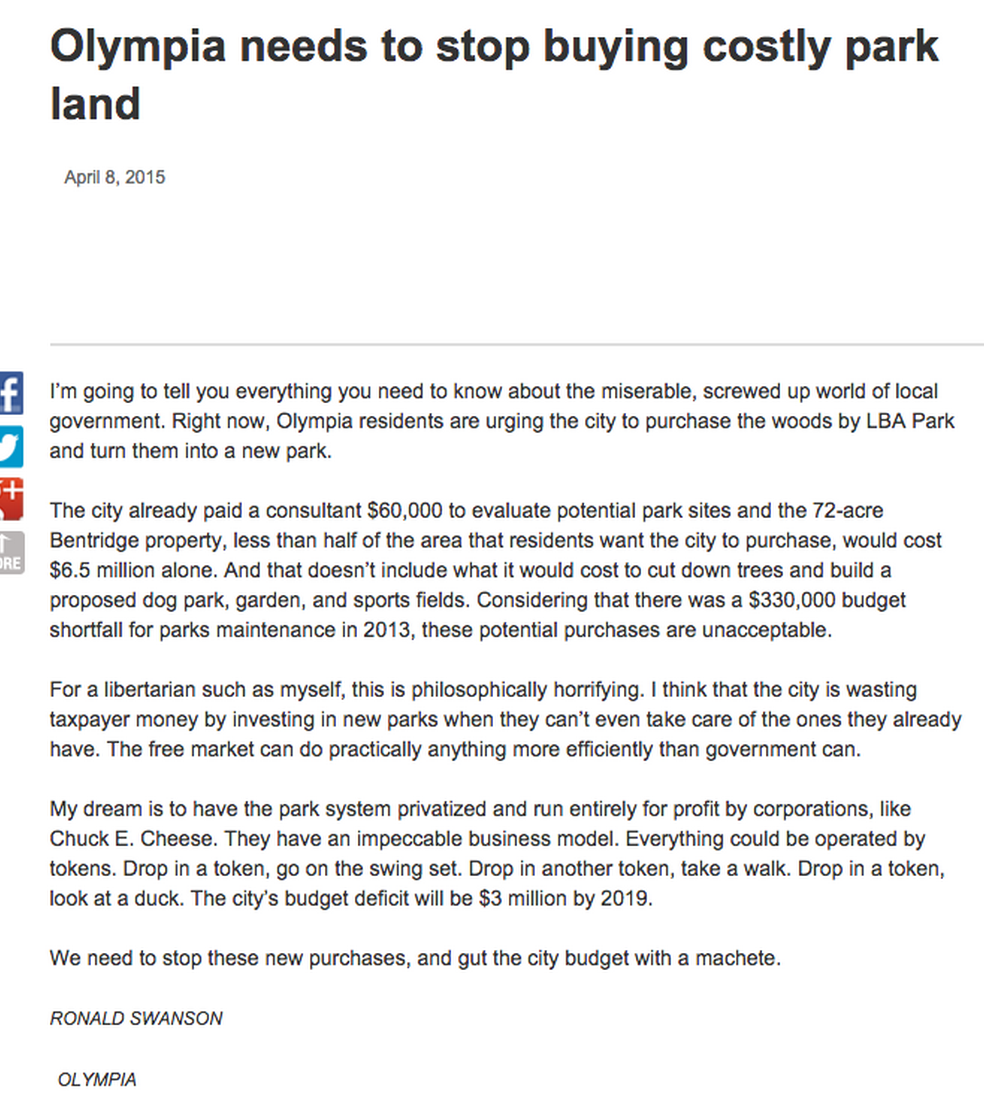Earlier this year, the Olympia School District released an audit of its public communications. This document offers a fascinating look into not only the district’s recent history and public narratives but also the general flow of information within our community.
Typically, such audits seek to understand how people perceive what’s happening in their community. The Olympia audit, for example, asked, “How do you learn about the Olympia School District?” with options like “local media,” “word of mouth,” and “social media.”
Across the country, a clear trend has emerged: responses indicating “local media” are declining, while those pointing to “social media” are increasing.
However, the broad conclusion that more people are getting their local news from “social media” is problematic because the term itself is poorly defined. Few comprehensive surveys that include this question ask for specific examples. Is “social media” referring to posts from established news organizations? If so, shouldn’t that fall under the “local media” category? Or is it truly just individuals posting on various platforms? If so, which ones? The wild, woolly frontier of social media needs to be understood, not just broadly categorized.
To genuinely understand how information flows through our community, to do the real work of helping people grasp “the news,” we need to comprehend the entire ecosystem. Simply categorizing it as “social media” feels like shrugging and walking away. This isn’t an accusation but a call for a more precise framework for approaching the question.
Analyzing the Local News Landscape
Similar to the communications audit, there have been a couple of attempts to understand the changing shape and decline of local media.
I have significant concerns with the Washington State University (WSU) research. While their approach is sound, they make some simple categorization mistakes. For instance, Olympia, as the state capital, naturally has more news sources (like TVW and the Washington State Standard). However, the WSU study also includes two North America Talks platforms in our Olympia count that do not cover local Olympia news. Thurston Talk is their local brand here, but South Sound Talk covers Pierce County. While “South Sound Talk” might be vaguely interpreted, “Whatcom Talk” clearly covers Whatcom County, a detail they should have identified.
Another study, using Muckrack data, tracks the decline of local journalism over the past two decades. In Thurston County, it estimates approximately 6.3 “Local Journalist Equivalents” per 100,000 residents, which would mean nearly 20 local reporters. This number feels a bit high, but their methodology section is clear, so I plan to delve into their data further for a better understanding.
However, these analyses often overlook the entire other section of where people report getting their local news: social media. When I conducted a back-of-the-napkin analysis for Thurston Community Media on the local media landscape, I generally found what others did: a decline in established, professional local media (e.g., the loss of the KGY newsroom, the decline of The Olympian), the rise of digital-only platforms that approach news differently, and the creation of several social media forums that seemingly replace traditional news. Specifically, I noted r/Olympia on Reddit, the Thurston Scanner Facebook page, and the now-private Olympia Looks like Shit Facebook group.
The Dangers of Misinformation in a Fragmented Ecosystem
An incident just yesterday highlighted how this evolving dynamic, particularly with newly established digital platforms, can spark misinformation and how quickly that misinformation can become political fuel. A recent article from The JOLT at best poorly described, at worst mischaracterized a key point in an Olympia City Council meeting. The JOLT’s practice is to outsource most of its reporting to overseas reporters, relying on video footage rather than on-the-ground context.
The topic was a state-funded program designed to move unhoused individuals off state highway rights-of-way within city limits into more stable housing, think of the Interstate 5 embankment next to Hobby Lobby on Sleater-Kinney, which is inside Olympia but on state-owned land. Councilmember Dani Madrone described the situation as one where the state essentially handed local governments money and said:
“…local governments are in this position of, you know, the state said, “Here’s some money to get the folks without housing off state lands, bring them into your jurisdiction, and then, you know, you better hope we continue to fund it.”
However, the reporter misunderstood and misquoted her, framing it as though Olympia was intentionally bringing in unhoused people from outside the city:
“Madrone pointed out that local governments were encouraged to bring unhoused individuals into their jurisdictions with the promise of continued state funding. “
The reporter heard Councilmember Madrone say something about the city “bringing people into the jurisdiction,” but misinterpreted it in a way that what they wrote meant to the reader Olympia was importing people from outside city. Had they been present in the room, they would have been able to follow up and understand she was referring to unhoused individuals already living on state rights-of-way within the city. A simple clarification could have prevented significant confusion.
This misquote quickly took on a life of its own. A city council candidate picked up the inaccurate paraphrase and incorporated it into a version of the “magnet theory,” the unfounded idea that Olympia is importing unhoused people to boost its budget.

In reality, the right-of-way program aims to help cities manage homelessness that already exists within their boundaries, but on state-owned land. As of the following day, the post had been shared 43 times on Facebook, and I could only see a handful of those shares, some of which might be in active Facebook groups I’m not part of. This only tracks the story’s spread via Facebook on its first day.
This situation highlights a dangerous chain reaction: poor paraphrasing by an out-of-area reporter led to a public misconception, which was then used to fuel a misleading political narrative. It serves as a stark reminder that local journalism requires both proximity and precision, especially when reporting on sensitive, politicized issues like homelessness.
This incident also underscores a larger problem: the way we talk about “social media” as if it were a single entity. It’s not. Local Facebook groups operate differently from Nextdoor or a subreddit. And for each community, these local online communities are different. Understanding how information and misinformation flow through these distinct channels, and how it is received and reframed by different audiences, is as crucial as getting the facts right in the first place. We cannot mend local news if we don’t understand how people perceive it, and that perception is increasingly shaped by a fragmented, algorithmic media landscape.
Despite the practices of one seemingly legitimate online news organization, local journalism matters. So does understanding the ecosystem that surrounds it. If we are serious about either, we need to be more precise in our reporting and in our analysis of how that reporting moves through our communities.
The Future of Local Information
We are in the midst of a transitional moment for local news and information ecosystems, and we need better tools and frameworks, not just to fix the supply of local journalism but to understand how people receive and reprocess that information in a fragmented digital world.
The mangled “right-of-way” quote was misunderstood, amplified by a local candidate, and reframed as part of a broader narrative about Olympia intentionally importing unhoused people. A single reporting error, left unchallenged, became political fodder across local social channels.
This isn’t just a failure of journalism; it’s a failure of how we understand the local information ecosystem. As traditional newsrooms shrink, digital-only platforms emerge, and community conversations shift to increasingly opaque or siloed online spaces, we need new approaches to track and support the health of our local discourse.
Pulling back from Olympia, we’re seeing this debate occur on a national scale as people reading the tea leaves of the last Presidential race implore Democrats not to depend so heavily on legacy media strategies but to engage in the influencer space more.
We’re also seeing the promise of closed, walled garden social media pay off as the broader media industry is facing a “web traffic apocalypse.” The usual sources of online readership like Google Search, Facebook, and Twitter, have either deprioritized news or made algorithmic changes that dramatically reduce referral traffic.
Hope
There are also options to not just bring more reporters to town, but to grow and heal local social media. Organizations like New_Public are exploring how to treat digital public spaces like parks or libraries, shared infrastructure that communities must tend to, not just scroll past.
If we want to strengthen local journalism and civic trust, we can’t just ask where people get their news; we have to understand how that news is distorted, reshaped, or ignored once it enters the digital bloodstream. The future of local news doesn’t just depend on reporters. It depends on recognizing the complexity of the ecosystem we’re already in.






